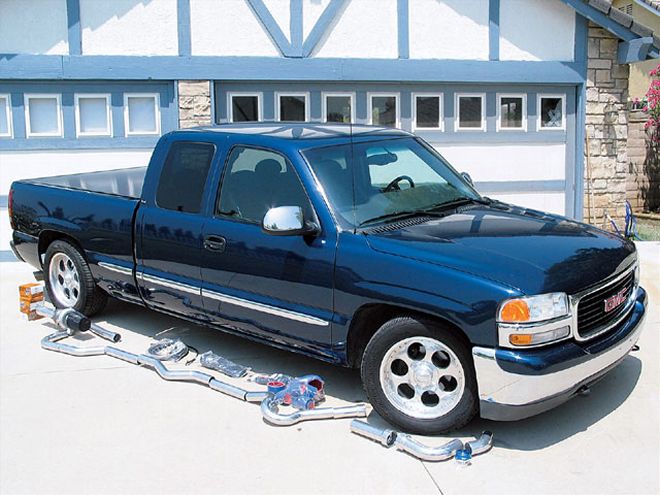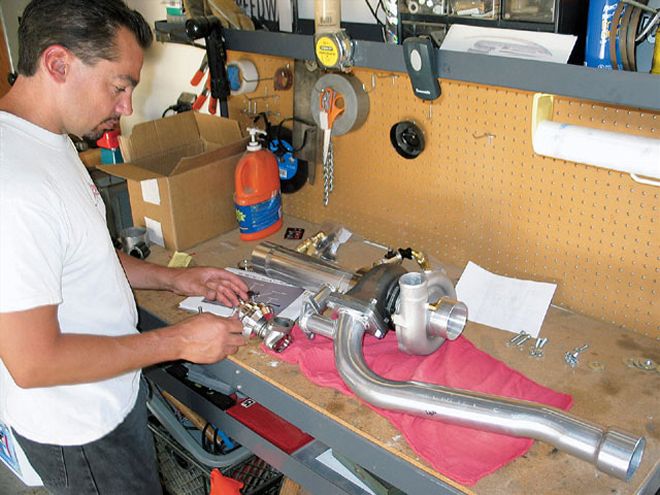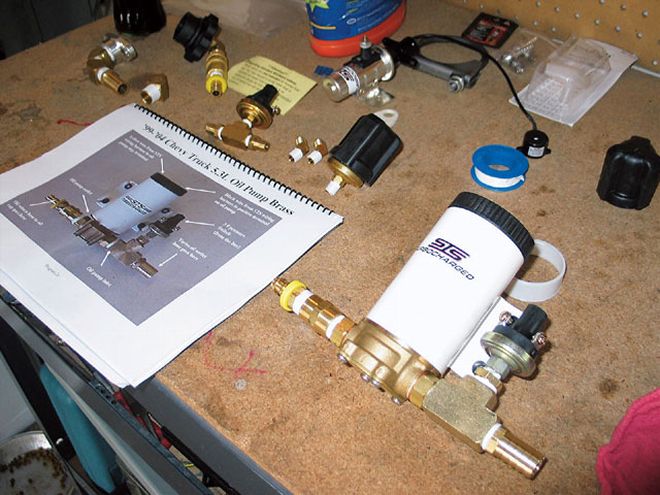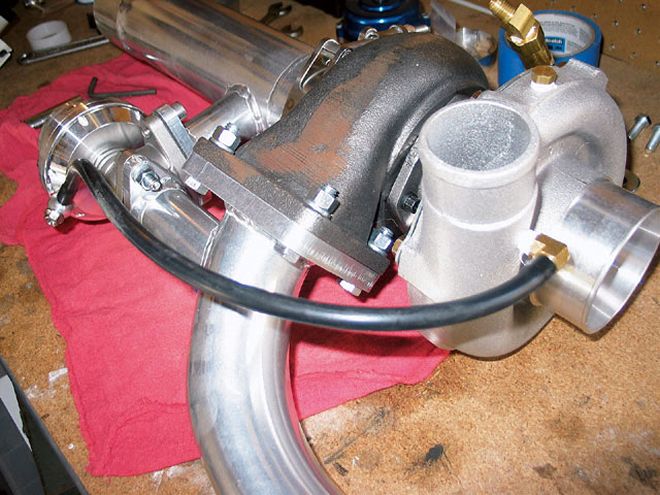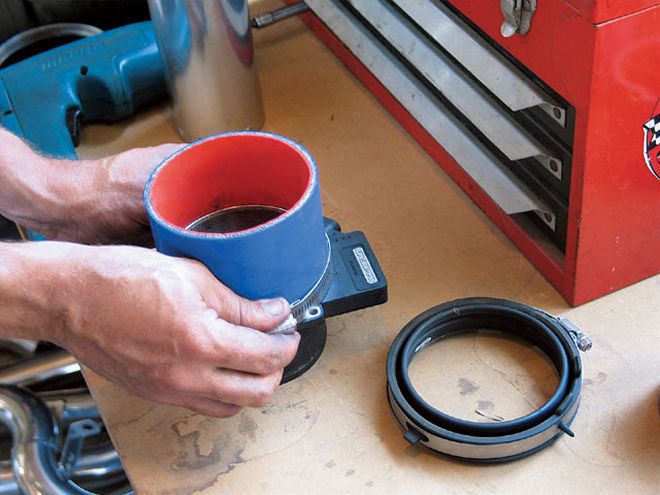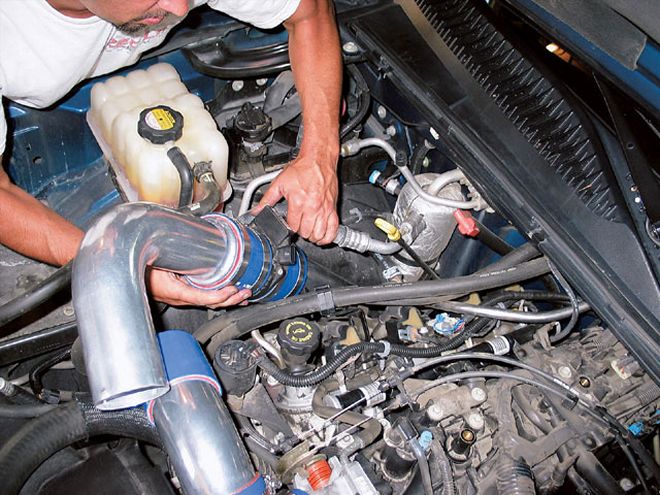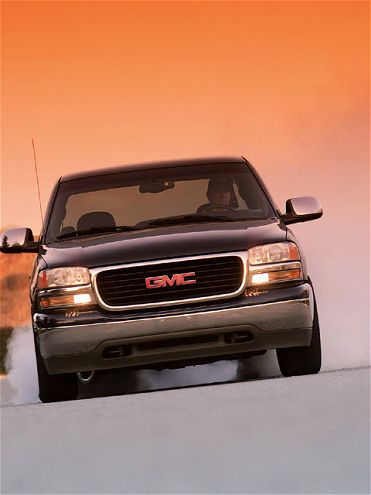
| tailpipe Turbo gmc Silverado Sierra
Turbochargers may see a resurgence in popularity if Rick Squires of Squires Turbo Systems has his way. He's the man behind the remote-mount turbocharger concept, where the turbocharger unit is mounted outside of the engine bay. There are many advantages to this layout.
For starters, Rick Squires asserts his turbocharger systems can be installed in four to six hours with standard tools and average mechanical ability because you don't have to relocate accessory drives, radiators, and so on. After installing the system in our test truck, we can vouch that his time-to-install estimate is valid. It's a simple direct bolt-on that the author and a mechanic pal from Online-Racer.com installed in about seven hours. That's an hour longer than estimated, but the author was stopping work constantly to take pictures.
In addition, the remote mount provides lower underhood temperatures, so you don't need to worry about melting wires, hoses, or other components. You retain the room under the hood, so future repair work or modifications doesn't involve removing the turbo system. You get cooler oil to the turbocharger and cooler oil returned to your engine, as well as increased oil capacity. The turbo runs approximately 500 degrees F lower than traditional systems, thus eliminating the need for a turbo timer. The timer allows the engine to run after the truck is shut off, in order to cool down the turbo and prevent oil and bearing damage. There are a dozen or so more convenience and reliability advantages that are highlighted on the STS Web site, so we'll direct you there for more detailed information.
For now, however, we'll concentrate on the performance advantages, including the claim that denser exhaust gasses drive the turbocharger turbine wheel more efficiently. Another advantage is good intercooler efficiency without the expense, pressure drop, and installation problems associated with a front-mounted intercooler. The turbocharger is exposed to ambient air rather than underhood air, which allows for better cooling of turbocharger components, and you don't need expensive headers, mufflers, or exhaust systems. And because the turbocharger is closer to the tailpipe outlet, you get a greater pressure differential across the turbine wheel, which promotes better flow across turbine - in other words, more boost, quicker. Plus, it's easy to convert back to stock; about a two-hour job by STS estimates.
When we first saw this turbo system at last year's SEMA Show, we were very skeptical about the throttle response. We thought that with the turbo so far away from the combustion chamber, the system would be lazy with a lot of turbo lag. But after driving the system on other trucks as well as on this install, we find the lag not excessive in the least; it is very near what you find on factory turbo systems.
OK so far, but how much power does it make?
Our test rig is a '99 GMC Sierra with a 4.8L engine backed by a four-speed automatic with 85K miles on the clock. The factory says it makes SAE-corrected 255 hp at 5,200 rpm and 285 lb-ft of torque at 4,000 rpm. With a MagnaFlow stainless-steel after-cat system and TrueFlow intake installed, we added around 10 to 12 hp to that figure. That puts 265 SAE ponies at the flywheel, which should translate into approximately 220 to 225 hp at the wheels.
We recorded 225 peak horsepower as baseline on the West Tech Superflow chassis dyno using Standard Temperature and Pressure (STP) correction factors. SAE-corrected figures are lower than STP-corrected numbers (see sidebar). Torque peaked at 238 lb-ft. These power levels correspond appropriately to the mph we saw in our quarter-mile testing of the baseline combo.
After we installed the STS turbo system, well, the dyno information tells the tale. This system bolted on a legit 77 hp and 82 lb-ft of torque peak-to-peak - on a '99 4.8L, without any engine management tuning. Needless to say, we're extremely impressed with the package.
The added power resulted in clipping nearly a second of the e.t. with an increase of 8 mph. As cool as that is, it's cooler still, since the cruise control works fine, and with the added torque, it stays in Overdrive in situations that'd usually force a shift. The result is a surprising increase in mpg.
In driving it around town and over a couple of really steep and long grades, all the while watching the scanner, we're happy to report that the stock engine management system works seamlessly at the 0.4 bar (we saw a maximum 5.6-psi boost in the engine) boost limit on the wastegate. Maximum intake temps settled in at 165 degrees F with 8 degrees timing advance during a 100 percent throttle-angle induced acceleration from 65 to 85 mph on the steepest part of the climb. (No grade signs were visible, so we can't report on the grade percent. See sidebar for more details.)
About the only thing we'd change on the system is the low clearance of the intake that drops around a body mount just behind the front wheel; there has be a better way, and we're sure the STS crew is noodling on a solution for that. Also, we're definitely going to relocate the air filter to a place that'll pick up cooler air. It's pretty low to the ground, so it picks up air heated by the road surface as well as the heated air from cooling the engine. Relocating the air filter will be relatively easy and should show some power increases, as well as reducing the potential of causing the engine to sense detonation and pull timing out. We also want to move it higher to avoid filling the intake with water if we accidentally drive through some deep water. Some ducting and a few clamps will fix it relatively easily.
How's The STS Turbo'ed 4.8L LS1 Rate Against Modern Muscle?
Last year, we tested the current crop of muscular sport trucks. On top, the Lightning, as expected, overpowered the SS and the Hemi in the acceleration tests with a 6.18-second 0-to-60-mph time and 14.62-at-97.48-mph quarter-mile e.t. The naturally aspirated SS and Hemi pickup trucks were more than a second slower. The SS Silverado high-output 6.0L managed to reach 60 mph from a standing start in 7.44 seconds and traveled the quarter-mile in 15.79 seconds at 87.47 mph for a distant Second Place finish. It barely edged by the Hemi's performance of a 0-to-60-mph time of 7.7 seconds and an e.t. of 15.98 seconds at 86.84 mph. So our 15.87 at 91.3 mph puts our STS turbo'ed 4.8L in some factory-fast company - high-15-second e.t's and mid-7-second 0 to 60 mph. And we haven't begun to tune it yet. In addition, we're very happy and grateful for the improved highway fuel economy. On a 200-mile round-trip highway cruise, our tester got 21.5 mpg. So if you're looking for a power adder for your sport truck, we recommend you take a look at the STS remote-mount turbocharger system.
Road Test Specs:Hill climb: 1,650 ft to 4,117 ft
Ambient temp: 90 degrees F
Highest intake temp: 165 degrees F
(accelerating from 65 to 85 mph on steepest grade)
Cruise (70 mph) intake temp: 122 F
200-Mile test loop: 21.5 mpg
60 MPH, level road: 26 mpg
How To Bolt On The STS Remote-Mount Turbo System In Less Than Eight HoursNext to a nitrous system, there isn't an easier way to bolt-on a legit 75hp power-adder than the STS remote-mount turbocharging system. (Plus, the turbo mounts after the cat so it tends to be emissions friendly; just to be safe, check your states regulations.) We did it in a home garage with typical handtools, a floor jack, and some jackstands, in less that eight hours. And we were stopping all the time to take pictures. Here's how we did it.
Before installing this system, we spent about an hour or so getting familiar with it and making sure it was shipped complete (it was). Then we hooked up the oil pump to the battery and ran it the five minutes required to break in the brushes on the electric motor as per the instruction book; it's noisy, so don't let that spook you. After that, be sure to disconnect the negative terminal from the battery before beginning your installation.
Next, after applying the Teflon sealing tape to the brass fittings for the oil pump connections, the PCV switch, and the wastegate connections, making sure not to block or reduce the flow by keeping the tape away from the openings, we assembled the fittings in preparation for assembling the turbocharger and wastegate. After that, we installed the exhaust-inlet pipe using antiseize on the bolts and installed the exhaust-outlet pipe using the supplied clamp. This is the point where we catch up with our speedy driveway how-to installer, Nick Burr from Online-Racer.com, and your humble correspondent with wrench and camera in hand.
Correction Factors
According to Superflow tech wiz Harold Bettes, it is very standard in the industry to compare NA and supercharged or turbocharged power tests in the normal way with either SAE or STP power-correction applied. Current SAE is corrected to 29.23 inches-hydrogen, with 77 degrees F, dry air. Of course, the STP or STD correction corrects to conditions of 29.92 inches-hydrogen, and 60 degrees F, dry air. Applying these correction factors is the standard process of comparison, even in the diesel industry, using very high boost numbers, such as 20 or more psi.
Quick Spec Check:
Wt. w/ driver: 4,840 lbs
Baseline 1/4-mile: 16.87 @ 83 mph
W/ STS turbo 1/4-mile: 15.89 @ 91 mph
Dyno test
hp* Peak to Peak
STS Turbo: 303 @ 5,086
Stock: 226 @ 5,256 +77
Tq* Peak to Peak
STS Turbo: 321 @ 4,352
Stock: 239 @ 4,218 +82
Average hp (3,200 to 5,400 rpm)
STS Turbo: 253
Stock: 193 +60
Average Tq (3,200 to 5,400 rpm)
STS Turbo: 300 lb-ft
Stock: 233 lb-ft +67 lb-ft
Rear wheel is power-corrected to Standard Temperature and Pressure (STP). SAE-corrected power figures would be lower.
Baseline Chp: naturally aspirated, MagnaFlow Exhaust, TrueFlow intake
STS Chp: remote-mount turbo 0.4 bar wastegate spring
RPM STS CHP* BASE CHP* GAIN 3,258 156.2 136.8 19.4 + 3,374 {{{164}}}.8 145.3 19.5 + 3,487 173.5 153.8 19.7 + 3,544 190.7 157.2 33.5 + 3,658 197.3 163.3 34 + 3,768 207.9 169.3 38.6 + 3,{{{825}}} 216.2 172.1 44.1 + 3,936 232.6 177.9 54.7 + 4,049 {{{240}}}.6 183.1 {{{57}}}.5 + 4,163 248.1 189.2 58.9 + 4,275 261.1 193.6 67.5 + 4,331 266.3 195.8 70.5 + 4,443 270.1 200.6 69.5 + 4,555 277.5 204.9 72.6 + 4,666 282.5 209.4 73.1 + 4,776 286.9 212.9 74 + 4,886 294.4 217 77.4 + 4,942 297.5 218.9 78.6 + 5,049 302.8 222 {{{80}}}.8 + 5,154 302.3 224.6 77.7 + 5,256 299.5 225.6 73.9 + 5,355 290.3 224.8 65.5 + 5,402 276.8 224 52.8 +
RPM STS CTQ* BASE CTQ* GAIN 3,258 248.6 220.6 28 + 3,374 257.1 226.3 30.8 + 3,487 264.7 231.6 33.1 + 3,544 279.2 232.9 46.3 + 3,658 282.6 234.5 48.1 + 3,768 291.9 235.9 56 + 3,825 297.5 236.3 61.2 + 3,936 307.5 237.3 70.2 + 4,049 312 237.5 74.5 + 4,163 315.9 238.7 77.2 + 4,275 320.6 237.8 82.8 + 4,331 321.4 237.5 83.9 + 4,443 320.4 237.1 83.3 + 4,555 318.2 236.3 81.9 + 4,666 318.8 235.7 83.1 + 4,776 318.6 234.20 84.4 + 4,886 317.1 233.3 83.8 + 4,942 315.6 232.7 82.9 + 5,049 312.6 230.9 81.7 + 5,154 308.1 228.9 79.2 + 5,256 301.5 225.4 76.1 + 5,355 285.8 220.5 65.3 + 5,402 266.9 217.8 49.1 +
 | tailpipe Turbo gmc Silverado Sierra
Turbochargers may see a resurgence in popularity if Rick Squires of Squires Turbo Systems has his way. He's the man behind the remote-mount turbocharger concept, where the turbocharger unit is mounted outside of the engine bay. There are many advantages to this layout.
For starters, Rick Squires asserts his turbocharger systems can be installed in four to six hours with standard tools and average mechanical ability because you don't have to relocate accessory drives, radiators, and so on. After installing the system in our test truck, we can vouch that his time-to-install estimate is valid. It's a simple direct bolt-on that the author and a mechanic pal from Online-Racer.com installed in about seven hours. That's an hour longer than estimated, but the author was stopping work constantly to take pictures.
In addition, the remote mount provides lower underhood temperatures, so you don't need to worry about melting wires, hoses, or other components. You retain the room under the hood, so future repair work or modifications doesn't involve removing the turbo system. You get cooler oil to the turbocharger and cooler oil returned to your engine, as well as increased oil capacity. The turbo runs approximately 500 degrees F lower than traditional systems, thus eliminating the need for a turbo timer. The timer allows the engine to run after the truck is shut off, in order to cool down the turbo and prevent oil and bearing damage. There are a dozen or so more convenience and reliability advantages that are highlighted on the STS Web site, so we'll direct you there for more detailed information.
For now, however, we'll concentrate on the performance advantages, including the claim that denser exhaust gasses drive the turbocharger turbine wheel more efficiently. Another advantage is good intercooler efficiency without the expense, pressure drop, and installation problems associated with a front-mounted intercooler. The turbocharger is exposed to ambient air rather than underhood air, which allows for better cooling of turbocharger components, and you don't need expensive headers, mufflers, or exhaust systems. And because the turbocharger is closer to the tailpipe outlet, you get a greater pressure differential across the turbine wheel, which promotes better flow across turbine - in other words, more boost, quicker. Plus, it's easy to convert back to stock; about a two-hour job by STS estimates.
When we first saw this turbo system at last year's SEMA Show, we were very skeptical about the throttle response. We thought that with the turbo so far away from the combustion chamber, the system would be lazy with a lot of turbo lag. But after driving the system on other trucks as well as on this install, we find the lag not excessive in the least; it is very near what you find on factory turbo systems.
OK so far, but how much power does it make?
Our test rig is a '99 GMC Sierra with a 4.8L engine backed by a four-speed automatic with 85K miles on the clock. The factory says it makes SAE-corrected 255 hp at 5,200 rpm and 285 lb-ft of torque at 4,000 rpm. With a MagnaFlow stainless-steel after-cat system and TrueFlow intake installed, we added around 10 to 12 hp to that figure. That puts 265 SAE ponies at the flywheel, which should translate into approximately 220 to 225 hp at the wheels.
We recorded 225 peak horsepower as baseline on the West Tech Superflow chassis dyno using Standard Temperature and Pressure (STP) correction factors. SAE-corrected figures are lower than STP-corrected numbers (see sidebar). Torque peaked at 238 lb-ft. These power levels correspond appropriately to the mph we saw in our quarter-mile testing of the baseline combo.
After we installed the STS turbo system, well, the dyno information tells the tale. This system bolted on a legit 77 hp and 82 lb-ft of torque peak-to-peak - on a '99 4.8L, without any engine management tuning. Needless to say, we're extremely impressed with the package.
The added power resulted in clipping nearly a second of the e.t. with an increase of 8 mph. As cool as that is, it's cooler still, since the cruise control works fine, and with the added torque, it stays in Overdrive in situations that'd usually force a shift. The result is a surprising increase in mpg.
In driving it around town and over a couple of really steep and long grades, all the while watching the scanner, we're happy to report that the stock engine management system works seamlessly at the 0.4 bar (we saw a maximum 5.6-psi boost in the engine) boost limit on the wastegate. Maximum intake temps settled in at 165 degrees F with 8 degrees timing advance during a 100 percent throttle-angle induced acceleration from 65 to 85 mph on the steepest part of the climb. (No grade signs were visible, so we can't report on the grade percent. See sidebar for more details.)
About the only thing we'd change on the system is the low clearance of the intake that drops around a body mount just behind the front wheel; there has be a better way, and we're sure the STS crew is noodling on a solution for that. Also, we're definitely going to relocate the air filter to a place that'll pick up cooler air. It's pretty low to the ground, so it picks up air heated by the road surface as well as the heated air from cooling the engine. Relocating the air filter will be relatively easy and should show some power increases, as well as reducing the potential of causing the engine to sense detonation and pull timing out. We also want to move it higher to avoid filling the intake with water if we accidentally drive through some deep water. Some ducting and a few clamps will fix it relatively easily.
| tailpipe Turbo gmc Silverado Sierra
Turbochargers may see a resurgence in popularity if Rick Squires of Squires Turbo Systems has his way. He's the man behind the remote-mount turbocharger concept, where the turbocharger unit is mounted outside of the engine bay. There are many advantages to this layout.
For starters, Rick Squires asserts his turbocharger systems can be installed in four to six hours with standard tools and average mechanical ability because you don't have to relocate accessory drives, radiators, and so on. After installing the system in our test truck, we can vouch that his time-to-install estimate is valid. It's a simple direct bolt-on that the author and a mechanic pal from Online-Racer.com installed in about seven hours. That's an hour longer than estimated, but the author was stopping work constantly to take pictures.
In addition, the remote mount provides lower underhood temperatures, so you don't need to worry about melting wires, hoses, or other components. You retain the room under the hood, so future repair work or modifications doesn't involve removing the turbo system. You get cooler oil to the turbocharger and cooler oil returned to your engine, as well as increased oil capacity. The turbo runs approximately 500 degrees F lower than traditional systems, thus eliminating the need for a turbo timer. The timer allows the engine to run after the truck is shut off, in order to cool down the turbo and prevent oil and bearing damage. There are a dozen or so more convenience and reliability advantages that are highlighted on the STS Web site, so we'll direct you there for more detailed information.
For now, however, we'll concentrate on the performance advantages, including the claim that denser exhaust gasses drive the turbocharger turbine wheel more efficiently. Another advantage is good intercooler efficiency without the expense, pressure drop, and installation problems associated with a front-mounted intercooler. The turbocharger is exposed to ambient air rather than underhood air, which allows for better cooling of turbocharger components, and you don't need expensive headers, mufflers, or exhaust systems. And because the turbocharger is closer to the tailpipe outlet, you get a greater pressure differential across the turbine wheel, which promotes better flow across turbine - in other words, more boost, quicker. Plus, it's easy to convert back to stock; about a two-hour job by STS estimates.
When we first saw this turbo system at last year's SEMA Show, we were very skeptical about the throttle response. We thought that with the turbo so far away from the combustion chamber, the system would be lazy with a lot of turbo lag. But after driving the system on other trucks as well as on this install, we find the lag not excessive in the least; it is very near what you find on factory turbo systems.
OK so far, but how much power does it make?
Our test rig is a '99 GMC Sierra with a 4.8L engine backed by a four-speed automatic with 85K miles on the clock. The factory says it makes SAE-corrected 255 hp at 5,200 rpm and 285 lb-ft of torque at 4,000 rpm. With a MagnaFlow stainless-steel after-cat system and TrueFlow intake installed, we added around 10 to 12 hp to that figure. That puts 265 SAE ponies at the flywheel, which should translate into approximately 220 to 225 hp at the wheels.
We recorded 225 peak horsepower as baseline on the West Tech Superflow chassis dyno using Standard Temperature and Pressure (STP) correction factors. SAE-corrected figures are lower than STP-corrected numbers (see sidebar). Torque peaked at 238 lb-ft. These power levels correspond appropriately to the mph we saw in our quarter-mile testing of the baseline combo.
After we installed the STS turbo system, well, the dyno information tells the tale. This system bolted on a legit 77 hp and 82 lb-ft of torque peak-to-peak - on a '99 4.8L, without any engine management tuning. Needless to say, we're extremely impressed with the package.
The added power resulted in clipping nearly a second of the e.t. with an increase of 8 mph. As cool as that is, it's cooler still, since the cruise control works fine, and with the added torque, it stays in Overdrive in situations that'd usually force a shift. The result is a surprising increase in mpg.
In driving it around town and over a couple of really steep and long grades, all the while watching the scanner, we're happy to report that the stock engine management system works seamlessly at the 0.4 bar (we saw a maximum 5.6-psi boost in the engine) boost limit on the wastegate. Maximum intake temps settled in at 165 degrees F with 8 degrees timing advance during a 100 percent throttle-angle induced acceleration from 65 to 85 mph on the steepest part of the climb. (No grade signs were visible, so we can't report on the grade percent. See sidebar for more details.)
About the only thing we'd change on the system is the low clearance of the intake that drops around a body mount just behind the front wheel; there has be a better way, and we're sure the STS crew is noodling on a solution for that. Also, we're definitely going to relocate the air filter to a place that'll pick up cooler air. It's pretty low to the ground, so it picks up air heated by the road surface as well as the heated air from cooling the engine. Relocating the air filter will be relatively easy and should show some power increases, as well as reducing the potential of causing the engine to sense detonation and pull timing out. We also want to move it higher to avoid filling the intake with water if we accidentally drive through some deep water. Some ducting and a few clamps will fix it relatively easily.
